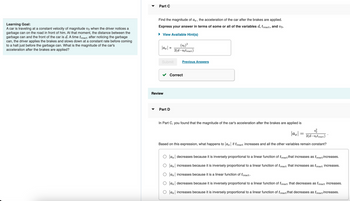Find the magnitude of ax, the acceleration of the car after the brakes are applied. Express your answer in terms of some or all of the variables d, treact, and vo. View Available Hint(s) |ax| = 17 ΓΙ ΑΣΦ ?
Find the magnitude of ax, the acceleration of the car after the brakes are applied. Express your answer in terms of some or all of the variables d, treact, and vo. View Available Hint(s) |ax| = 17 ΓΙ ΑΣΦ ?
University Physics Volume 1
18th Edition
ISBN:9781938168277
Author:William Moebs, Samuel J. Ling, Jeff Sanny
Publisher:William Moebs, Samuel J. Ling, Jeff Sanny
Chapter4: Motion In Two And Three Dimensions
Section: Chapter Questions
Problem 80AP: A particle travels m a circular orbit of radius 10 m. Its speed is changing at a rate of 15.0m/s2 at...
Related questions
Concept explainers
Topic Video
Question

Transcribed Image Text:Learning Goal:
A car is traveling at a constant velocity of magnitude vo when the driver notices a
garbage can on the road in front of him. At that moment, the distance between the
garbage can and the front of the car is d. A time treact after noticing the garbage
can, the driver applies the brakes and slows down at a constant rate before coming
to a halt just before the garbage can. What is the magnitude of the car's
acceleration after the brakes are applied?

Transcribed Image Text:Find the magnitude of ax, the acceleration of the car after the brakes are applied.
Express your answer in terms of some or all of the variables d, treact, and vo.
► View Available Hint(s)
|ax|
||
VE ΑΣΦ
?
Expert Solution
This question has been solved!
Explore an expertly crafted, step-by-step solution for a thorough understanding of key concepts.
This is a popular solution!
Trending now
This is a popular solution!
Step by step
Solved in 3 steps with 9 images

Follow-up Questions
Read through expert solutions to related follow-up questions below.
Follow-up Question

Transcribed Image Text:Learning Goal:
A car is traveling at a constant velocity of magnitude vo when the driver notices a
garbage can on the road in front of him. At that moment, the distance between the
garbage can and the front of the car is d. A time treact after noticing the garbage
can, the driver applies the brakes and slows down at a constant rate before coming
to a halt just before the garbage can. What is the magnitude of the car's
acceleration after the brakes are applied?
Part C
Find the magnitude of ax, the acceleration of the car after the brakes are applied.
Express your answer in terms of some or all of the variables d, treact, and vo.
View Available Hint(s)
|ax|
=
Submit
Review
(vo) ²
2(d-votreact)
Part D
Previous Answers
Correct
In Part C, you found that the magnitude of the car's acceleration after the brakes are applied is
|ax|
v²/
2(d-votreact)
Based on this expression, what happens to |ax| if treact increases and all the other variables remain constant?
=
|ax| decreases because it is inversely proportional to a linear function of treact that increases as treact increases.
|ax| increases because it is inversely proportional to a linear function of treact that increases as treact increases.
O ax increases because it is a linear function of treact.
O ax decreases because it is inversely proportional to a linear function of treact that decreases as treact increases.
|ax| increases because it is inversely proportional to a linear function of treact that decreases as treact increases.
Solution
Knowledge Booster
Learn more about
Need a deep-dive on the concept behind this application? Look no further. Learn more about this topic, physics and related others by exploring similar questions and additional content below.Recommended textbooks for you

University Physics Volume 1
Physics
ISBN:
9781938168277
Author:
William Moebs, Samuel J. Ling, Jeff Sanny
Publisher:
OpenStax - Rice University

University Physics Volume 1
Physics
ISBN:
9781938168277
Author:
William Moebs, Samuel J. Ling, Jeff Sanny
Publisher:
OpenStax - Rice University